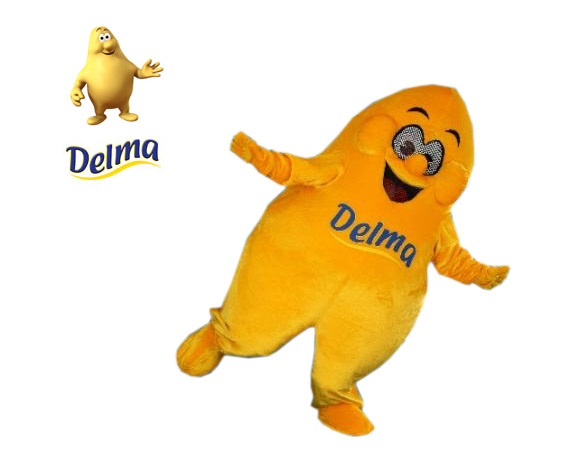Advertising costumes (masks - costumes)
The new costume-mask for DELMA products, they can now use this yellow character for advertising

More about Delma Margarine:
Delma is a name of number of products, such as margarine. This brand name has created a new advertising costume (or advert costume/ or promotional costume). This Delma’s advertising costume is yellow, made from good quality material. It is soft and non allergic. This promotional costume is very comfortable, it has a holes for eyes, shoes and a head. Delma can now advertise herself on the street, in the meeting, at the shops and etc.
More about margarine:
The amount of saturated fat in margarine has consistently been falling and now, even at the highest end of the scale, content is at least 25% less than that of butter. Some contain up to 83% less saturated fat.
What is Fat? Not all fats are bad for health. The body needs around 70 grams for women (95 grams for men) of fat each day to remain healthy and most of this should be 'good' unsaturated fats. This is equal to about one third of the calories we eat each day. Margarine and spreads are a valuable source of these polyunsaturated and monounsaturated 'good' fats.
The term 'fat' refers to triacylglycerols (TAG), phospholipids and cholesteryl esters. Dietary fat consists predominantly (90-98%) of mixtures of TAG. TAG consist of three fatty acids linked to a glycerol backbone. The mixture of fatty acids within the TAG and thus dietary fat determines its melting properties, degree of saturation and health effects.
Margarine is a generic term for vegetable fat spreads, typically composed of vegetable oils. While butter is derived from animal fats, margarine is derived from plant oils and fats and skimmed milk. In some locales it is colloquially referred to as oleo, short for oleomargarine.
Margarine can be used for spreading or baking and cooking. It is also commonly used as an ingredient in other food products, such as pastries and cookies, for its wide range of functionalities.
Margarine originated with the discovery by Michel Eugène Chevreul in 1813 of margaric acid (itself named after the pearly deposits of the fatty acid from Greek, meaning pearl-oyster or pearl, or μαργαρίς (margarís), meaning palm-tree, hence the relevance to palmitic acid). Scientists at the time regarded margaric acid, like oleic acid and stearic acid, as one of the three fatty acids which, in combination, formed most animal fats. In 1853, the German structural chemist, Wilhelm Heinrich Heintz, analyzed margaric acid as simply a combination of stearic acid and of the previously unknown palmitic acid.
Since margarine intrinsically appears white or almost white, by forbidding the addition of artificial colouring agents, legislators found that they could protect the dairy industries by discouraging the consumption of margarine based on visual appeal. Bans on adding colour became commonplace in the U.S., Australasia and Canada and, in some cases, those bans endured for almost 100 years. It did not become legal to sell coloured margarine in Australia, for example, until the 1960s. The rivalry between the dairy industry and the oleomargarine industry persists even today.
Emperor Louis Napoleon III of France offered a prize to anyone who could make a satisfactory substitute for butter, suitable for use by the armed forces and the lower classes. French chemist Hippolyte Mège-Mouriès invented a substance he called oleomargarine, the name of which became shortened to the trade name "margarine". Mège-Mouriès patented the concept in 1869 and expanded his initial manufacturing operation from France but had little commercial success. In 1871, he sold the patent to the Dutch company Jurgens, now part of Unilever. In the same year the German pharmacist Benedict Klein from Cologne founded the first margarine factory "Benedict Klein Margarinewerke", producing the brands Overstolz and Botteram.
Read more on wikipedia.com
